



WAVRE, Belgium — 7 September 2023: iSTAR Medical, a medtech company delivering breakthrough eye care solutions to patients, today announces positive three-year data from the STAR-GLOBAL trial for MINIject®. The data was presented at the iSTAR Medical symposium which took place in June at the World Glaucoma Congress (WGC) in Rome, Italy.
STAR-GLOBAL is an extension trial investigating the long-term safety and efficacy of patients up to five-years of follow-up. Patients implanted with the MINIject® supraciliary MIGS device are invited to enroll into STAR-GLOBAL upon completion at two years of an iSTAR Medical trial, to continue follow-up from two to five years.
Data from STAR-GLOBAL
Interim data from 48 patients in the STAR-GLOBAL trial who completed three-year follow-up was presented by Dr Inder Paul Singh (The Eye Centers of Racine & Kenosha, WI, USA) during the iSTAR Medical symposium at WGC. The efficacy results indicate a sustained, meaningful 36% reduction of eye pressure at three years with 42% of patients being medication-free. A favorable safety profile including corneal health was confirmed at three-year follow-up, with no serious adverse events related to the device or procedure in the STAR-GLOBAL follow-up period.
Dr Inder Paul Singh, glaucoma specialist and President of The Eye Centers of Racine & Kenosha, and presenter of the results at WGC, said:
Michel Vanbrabant, CEO of iSTAR Medical, added:
MINIject® is iSTAR Medical’s minimally-invasive glaucoma surgery (MIGS) device and is currently the only commercially available supraciliary MIGS implant.
About iSTAR Medical
iSTAR Medical is committed to delivering breakthrough eye care solutions. Our most advanced product, MINIject®, is approved in Europe for the treatment of open-angle glaucoma – the leading cause of irreversible blindness – and we are aiming to seek market approval in the US. We believe MINIject®’s distinctive tissue-integrating capabilities unlock a safer, and more effective option for patients. We are building an exceptional team and pipeline of potentially leading products such as MINIject® to establish new treatment paradigms in eye care conditions with the highest patient needs.
iSTAR Medical is an independent company which entered a strategic partnership with AbbVie (NYSE: ABBV) in July 2022. The collaboration further supports the role of MINIject® in the treatment of glaucoma and accelerates iSTAR Medical’s goal to bring MINIject® to more patients globally while providing AbbVie the opportunity to further expand its diverse eye care portfolio.
About MINIject®
MINIject® is iSTAR Medical’s innovative MIGS device for patients with primary open-angle glaucoma. MINIject® combines the distinctive porous structure of its proprietary STAR material with the power offered by the supraciliary space. As a result, it is designed to enhance natural fluid outflow, reducing intraocular pressure (IOP) and the need for medication, while bio-integrating with surrounding tissue, limiting inflammation, fibrosis and subsequent complications.
About Glaucoma
Glaucoma is a progressive disease affecting over 100 million people globally, of which primary open-angle glaucoma is the most common form.[1,2] IOP reduction, through medication or surgery, helps delay disease progression.[2] Medication is generally the first line treatment, but the progressive addition of multiple drops can burden patients with side effects, compliance challenges and costs.[2,3] Invasive surgery can present risks with irreversible complications and often requires long-term patient management.[2,3] MIGS is the most promising and fastest-growing glaucoma therapy due to its enhanced safety profile.[2] MINIject is potentially best-in-class for its promising long-term efficacy and safety.
[1] Jonas JB, Aung T, Bourne RR et al. “Glaucoma”. Lancet 2017; 390: 2083–93
[2] Market Scope, “2021 Glaucoma Surgical Device Market Report”, July 2021. https://www.market-scope.com/pages/reports/267/2021-glaucoma-surgical-device-market-report
[3] “European Glaucoma Society Terminology and Guidelines for Glaucoma”, 4th Edition: British Journal of Ophthalmology. 2017;101:1-195 https://bjo.bmj.com/content/101/5/73
 EN
EN